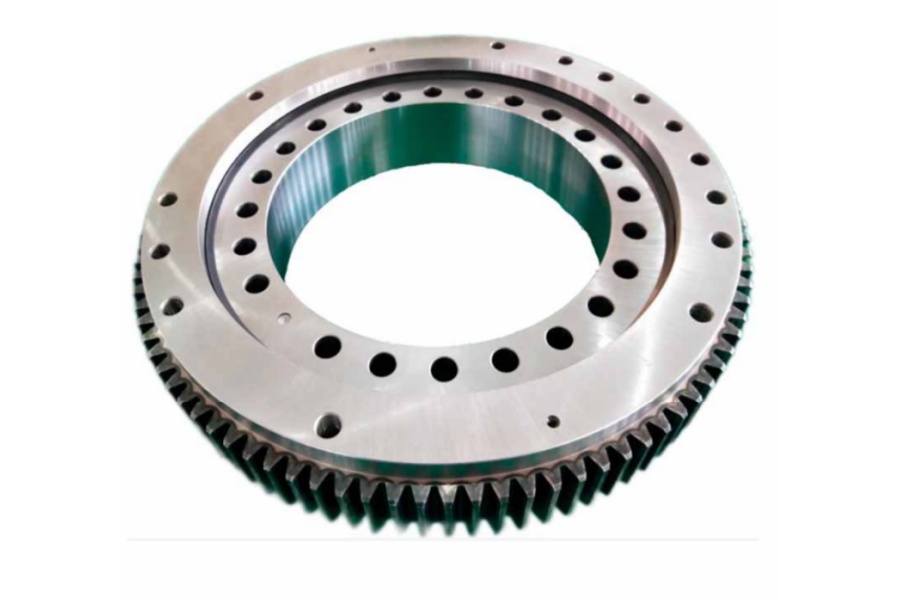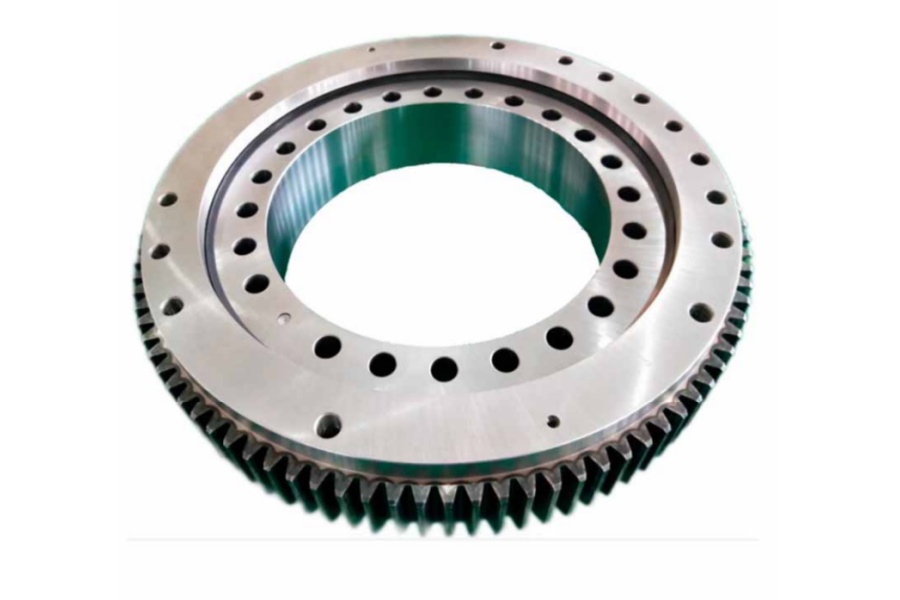
How to Machine Slewing Bearing Raceways After Quenching
What is Slewing Bearing
Slewing Bearing is a large-scale rotational rolling-element bearing fundamental to modern machinery, uniquely designed to support heavy combined loads—axial, radial, and moment loads—while enabling smooth, controlled rotation between two structures. Unlike standard bearings that are often ancillary components, slewing rings are integral structural elements that form a direct connection between a machine's upper structure (like a crane boom or excavator house) and its undercarriage. Their construction is characterized by a robust, compact design featuring two rings—either integral or mounted—with precision-machined raceways that accommodate balls or rollers. These rolling elements are typically spaced and guided by spacers or cages to ensure optimal load distribution and smooth operation. A defining feature of many slewing bearings is the inclusion of an integrated gear on either the inner or outer ring, which meshes with a pinion to create a compact and efficient drive system for rotational movement. Sealing systems are also paramount, protecting the critical rolling contact surfaces from contaminants like dirt, dust, and moisture, thereby ensuring long-term reliability and performance. Their versatility in handling complex load scenarios in a single, self-contained unit makes them indispensable components across a vast spectrum of industries, from construction and renewable energy to advanced medical and defense systems.

How to Machine Slewing Bearing Raceways After Quenching
The heat treatment process, specifically induction or flame hardening, is essential for creating a wear-resistant, hard surface on the slewing bearing raceways. However, this quenching process induces slight distortions and surface irregularities that must be precisely removed to achieve the final geometric accuracy and surface finish required for optimal bearing performance. The choice of machining method after quenching—grinding or hard turning—is a critical decision that significantly impacts the bearing's quality, production efficiency, and cost. Each method possesses distinct advantages and is selected based on the final application requirements of the slewing bearing.
Grinding is the traditional and most widely used method for finishing hardened raceways. This process employs a rotating abrasive grinding wheel to remove minute amounts of material from the raceway surface. The primary advantage of grinding lies in its exceptional ability to achieve a superior surface finish, typically reaching a roughness value of Ra0.8 or even lower when specialized grinding wheels are employed. Furthermore, the grinding process generates minimal cutting forces and stress, and the workpiece is usually held magnetically without radial clamping pressure. This combination of low stress and lack of mechanical distortion allows grinding to produce raceways with exceptionally high rotational accuracy and geometric perfection. This makes it the indispensable process for manufacturing high-precision slewing bearings, such as those requiring zero clearance (negative), high operational speeds, low noise generation, or those with ultra-thin cross-sections. However, a significant drawback of grinding, especially on conventional machines, is its relatively low processing efficiency. The need for skilled operators to constantly dress and maintain the grinding wheel shape, coupled with very small feed rates, results in longer production times.
In contrast, hard turning using computer numerical control (CNC) lathes has emerged as a highly efficient alternative. This process utilizes rigid machine tools and advanced, wear-resistant hard turning tools (often made of cubic boron nitride, CBN) to directly cut the hardened material. The most compelling advantage of hard turning is its dramatically higher processing efficiency. CNC lathes can operate with significantly faster feed rates and deeper cuts than grinding, drastically reducing the cycle time per part. The process is also highly repeatable and less dependent on operator skill for basic operation; once the program is verified, a less experienced operator can manage production. The geometric accuracy is controlled by the precise movements of the machine's axes, typically within 0.02mm, allowing it to easily machine perfect arcs, angles, and complex profiles as programmed. The surface roughness achieved by hard turning is generally in the range of Ra1.2 to Ra1.6, which is suitable for a vast majority of industrial applications. The main limitation is that the cutting forces involved can potentially cause microstructural alterations or residual stress in the very surface layer if not perfectly controlled, and the achievable surface finish, while good, does not typically match the pinnacle levels of grinding.
The selection between grinding and hard turning is therefore not a matter of superiority but of application-specific suitability. For demanding applications in heavy-load scenarios, defense, medical equipment, or any field where ultimate precision, longevity, and performance are non-negotiable, grinding remains the gold standard. For sectors like construction machinery and general engineering machinery, where cost-effectiveness, production throughput, and reliable performance within specified tolerances are the primary drivers, CNC hard turning offers an outstanding and efficient solution. A premier manufacturer will possess both capabilities, applying the correct process to meet the exact quality and performance demands of the customer's specific application.
Characteristics of Slewing Bearing
Slewing bearings are defined by a unique set of characteristics that differentiate them fundamentally from standard bearings and make them suitable for their role as both a bearing and a structural component. Their most prominent feature is the capacity to handle complex combined loads. A single slewing bearing can simultaneously support axial loads (parallel to the axis of rotation), radial loads (perpendicular to the axis), and tilting moment loads (which tend to overturn the structure), a capability that would otherwise require a complex system of multiple standard bearings. This multifunctional load-handling ability simplifies machine design, reduces the number of parts, and enhances overall structural integrity.
Another critical characteristic is their integrated design philosophy. Beyond just providing raceways for rolling elements, slewing bearings often incorporate multiple functionalities into one unit. The most common integration is a precision-machined gear, either on the inner or outer ring, which transforms the bearing into a compact rotational drive mechanism. They also come with mounting holes drilled and tapped directly into the rings, facilitating direct bolting to adjacent structures and eliminating the need for additional housings. Sealing systems are integral, typically consisting of elastomeric seals or labyrinth paths to effectively protect the internal components from harsh environmental contaminants. Many are also pre-fitted with lubrication fittings (grease nipples) and often channels to ensure the rolling elements and gear teeth are properly lubricated throughout their service life.
Durability and longevity are engineered into their core. Manufactured from high-quality, high-carbon chromium steel (e.g., 42CrMo4, 50Mn) and subjected to rigorous heat treatment processes like surface hardening, the raceways achieve a hard, wear-resistant surface while retaining a tough, shock-absorbing core. This ensures exceptional resistance to fatigue, pitting, and brinelling, even under heavy, cyclical loading conditions. Furthermore, their design often allows for versatility in size and customization. Slewing bearings are produced in a vast range of diameters, from a few hundred millimeters to over ten meters, and can be customized with specific seal types, gear geometries, hardening patterns, and hole configurations to meet the exact requirements of virtually any application, making them a highly adaptable engineering solution.
Applications of Slewing Bearing
The application of slewing bearings is virtually ubiquitous in any machinery that requires robust, controlled rotation under load. They are the fundamental enablers of movement in heavy industries. In construction and mining, they are the core component of excavators, allowing the house to rotate 360 degrees, and in mobile cranes, enabling the boom to lift and slew. Crawler cranes use them in their travel base, and they are found in tunnel boring machines, concrete pump trucks, and bulldozers.
The renewable energy sector is a major and growing application field. Slewing bearings are critical in the yaw systems of wind turbines, positioning the nacelle to face the wind, and in the pitch systems, adjusting the angle of the blades for optimal power generation and safety. In solar power, they are the key component in solar tracking systems, allowing photovoltaic panels to precisely follow the sun's path across the sky, significantly increasing energy yield.
In material handling, they are essential for port efficiency, operating in the stacking and reclaiming machines at shipping terminals and in the cranes that load and unload ships. They are found in rotary conveyors and the turntables of forklifts. The defense and aerospace sectors utilize high-precision slewing rings in radar and surveillance antennae for accurate positioning and tracking, in tank turrets for weapon aiming, and in missile launch systems.
The medical industry relies on specially designed, high-precision, and often cleanroom-compatible slewing bearings for advanced equipment such as CT scanners and MRI machines, where they enable the smooth and precise rotation of heavy imaging gantries around the patient. Finally, they are found in a multitude of industrial machines, including robotic welders and assemblers, indexing tables on CNC machining centers, packaging equipment, and even in large-scale industrial rotators and positioners. This immense diversity underscores their role as a critical, unsung hero in global industry and technology.
Factors Influencing the Price of Slewing Bearing
The price of a slewing bearing is determined by a complex interplay of technical specifications, material choices, and manufacturing overheads. Understanding these factors is crucial for making informed procurement decisions. The single largest cost driver is often the raw material. The type, grade, and quantity of steel required have a direct and significant impact. Standard carbon chromium steel is common, but applications requiring corrosion-resistant stainless steel (e.g., for marine environments) will see a substantial price increase due to the more expensive material and its more difficult machining and heat treatment. The physical dimensions—primarily the diameter, but also the width and height—directly scale the material cost.
The complexity of the manufacturing process is another major determinant. A standard, off-the-shelf bearing will be far less expensive than a fully customized one. Customizations such as integrated gearing (including the gear type, module, precision, and whether it is on the inner or outer ring), special sealing arrangements (multiple layers, specific elastomer compounds), unique mounting hole patterns, and special surface coatings (e.g., zinc plating for corrosion protection) all add significant steps, time, and specialized tooling to the production process, increasing cost.
The required precision tolerance grade and performance specifications dramatically influence price. A bearing manufactured to standard industrial tolerances for a digger arm is cost-effective. However, one produced to ultra-precise, micron-level tolerances for a medical CT scanner or a military radar, requiring 100% non-destructive testing (NDT) like magnetic particle inspection, full material traceability, and extended fatigue life testing, will command a premium price due to the extensive additional labor, slower production pace, and advanced quality assurance protocols involved.
The quantity ordered is a fundamental economic factor. Large volume production runs allow the manufacturer to amortize fixed costs (like custom tooling setup, CNC programming, and first-article inspection) over many units, drastically reducing the price per bearing. A one-off prototype or a small batch order will have a significantly higher unit cost. Finally, supply chain factors like global steel prices, logistics, and import/export tariffs can also cause fluctuations in the final price offered to the customer.
Supplier of Slewing Bearing
For engineers and procurement specialists seeking a reliable source for high-performance slewing bearings, LYRADRIVE stands as a manufacturer with deep expertise in both the engineering and production of these critical components. The company distinguishes itself through a command of the entire manufacturing process, including the critical post-quenching machining stages. LYRADRIVE's technical proficiency allows it to expertly select and apply the optimal finishing process—whether precision grinding for the most demanding applications or high-efficiency hard turning for robust industrial use—based on a clear understanding of the customer's performance requirements and operational environment. This technical decision-making is backed by a rigorous quality management system that ensures every bearing, from material selection to final inspection, meets stringent standards for durability, precision, and reliability. By offering this combination of advanced manufacturing capabilities, engineering-led problem-solving, and a commitment to delivering value, LYRADRIVE has established itself as a trusted partner for a global clientele across industries such as construction, renewable energy, material handling, and specialized industrial machinery.



